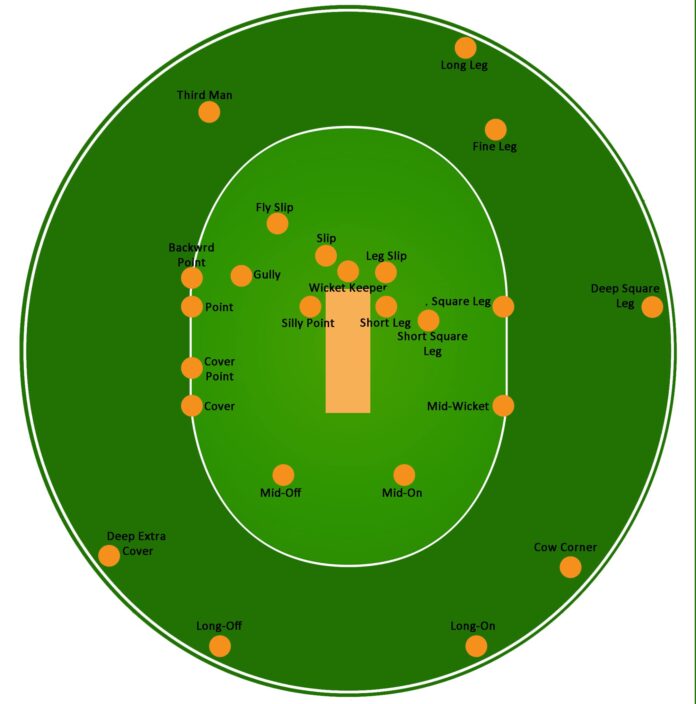Cricket is a game of strategy. In Cricket Fielding positions are key to executing those strategies. Each field position has a specific purpose. It helps the team take wickets and limit runs. Players and fans must understand these positions. It improves gameplay and appreciation for the sport’s nuances. This article will explore the fielding positions in cricket. We’ll discuss their roles and contributions to the game’s strategy.
Infield Cricket Fielding Positions
Infield cricket fielding positions are key for stopping quick singles and for catching chances close to the batsman. These positions require agility, quick reflexes, and sharp fielding skills.
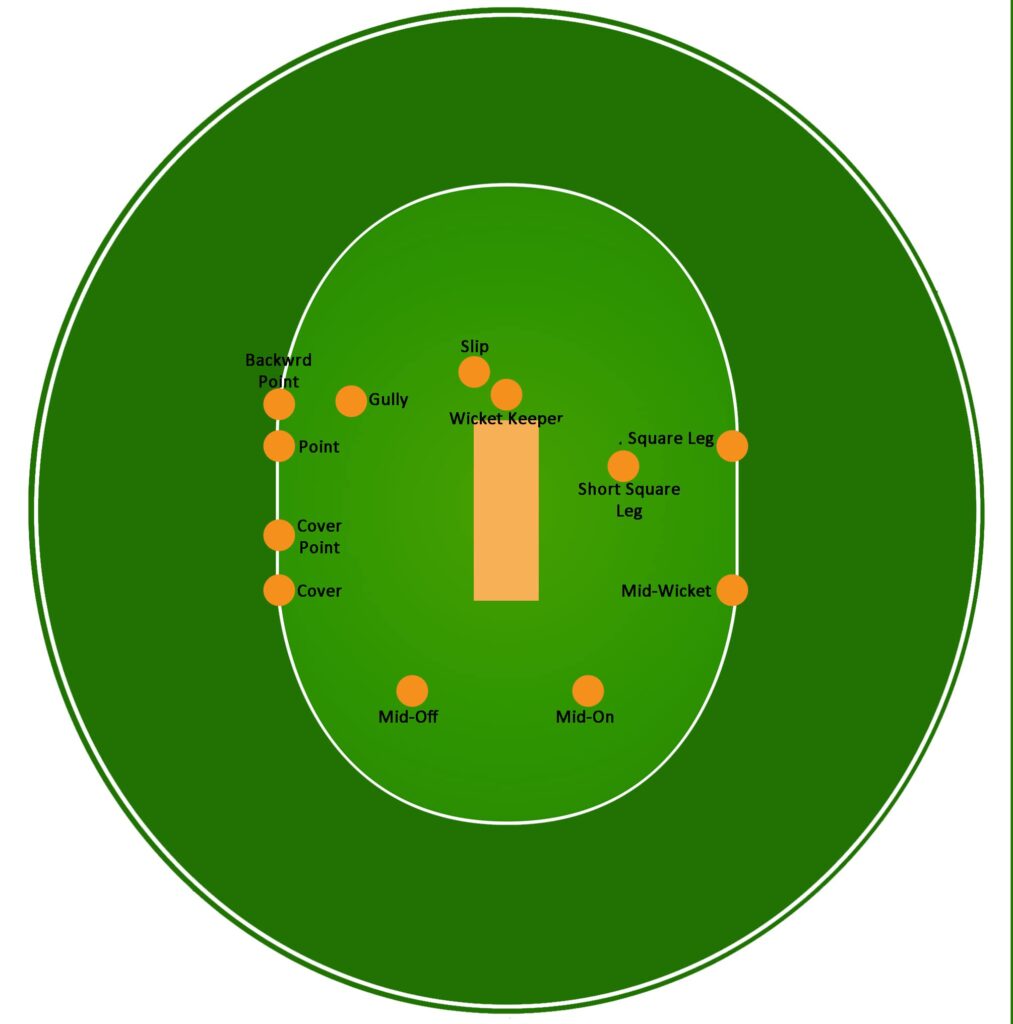
Slip
The slip is behind the batsman on the off-side, next to the wicketkeeper. Slips are crucial for catching edges from the batsman, particularly off fast bowlers. Depending on the situation, there can be multiple slips, known as first slip, second slip, and so on.
Gully
Positioned between the slips and point, the gully is another catching position designed to intercept balls that fly off the edge of the bat. The gully fielder needs to be alert and ready to dive for catches.
Point
The point fielder is stationed square of the wicket on the off-side. This position is key to stopping cuts and square drives. It requires quick reflexes and the ability to field hard-hit balls.
Backward Point
The backward point is positioned slightly behind the point fielder, closer to the boundary. This position is used to cut off late cuts and guide shots, especially against spinners and medium pacers.
Cover
The cover is located on the off-side, in front of the point and behind extra cover. This fielder is crucial for stopping drives and saving runs through the cover region.
Cover Point
The cover point is positioned between point and cover. The fielder in this position must intercept balls hit between point and cover.
Mid-Off
Mid-off is located straight and slightly wide of the bowler on the off-side. This position is essential for stopping straight drives and catching mistimed shots.
Mid-On
Mid-on is positioned straight and slightly wide of the bowler on the leg-side. This fielder is crucial for intercepting straight and on-drive shots from the batsman.
Midwicket
The midwicket is situated on the leg-side, between mid-on and square leg. This position is essential for stopping shots played across the line and for creating run-out opportunities.
Square Leg
The square leg is located on the leg-side, square to the wicket. This position is vital. It intercepts pull and hook shots. It also creates catching chances.
Short Square Leg
The short square leg is positioned closer to the batsman, near the square leg. This aggressive stance aims to catch short-leg shots and pressure the batsman.
Outfield Cricket Fielding Positions
Outfield cricket fielding positions are vital for cutting off boundaries and managing runs in the deep. These positions require speed, strong throwing arms, and the ability to anticipate the ball’s trajectory.
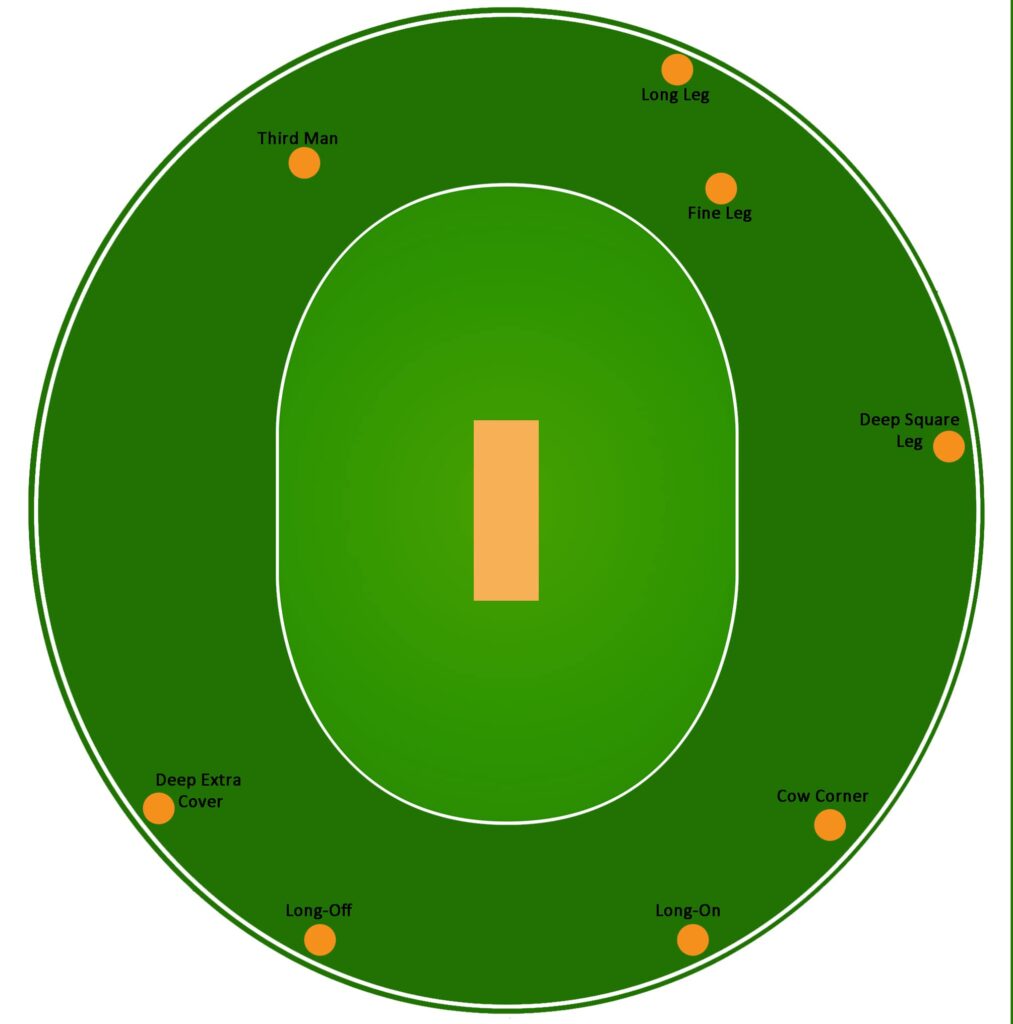
Third Man
The third man is located on the off-side, near the boundary behind the slips. This position is key for stopping edges that fly over or between the slip fielders, especially against fast bowlers.
Fine Leg
The fine leg is situated on the leg-side, near the boundary behind the wicketkeeper. This position is important for catching deflected glances and leg-side shots, as well as saving runs.
Long Leg
The long leg is positioned between fine leg and square leg on the boundary. This fielder must stop leg-side shots that are not fine enough for the fine leg position.
Deep Square Leg
The deep square leg is located on the leg side, near the boundary, square to the wicket. This position is used to intercept powerful pull and hook shots that are hit in the air.
Deep Midwicket
The deep midwicket is on the leg side, near the boundary between midwicket and long on. This position is vital for catching aerial shots and stopping boundaries hit through midwicket.
Long On and Long Off
Long on is at the leg-side boundary and Long off is at the off-side boundary. These positions are vital. They intercept lofted straight drives and cut-off boundaries.
Deep Extra Cover
Deep extra cover is positioned near the boundary in the cover region. This fielder must stop aerial shots and save runs in the cover area.
Cow Corner
Cow corner is an informal name for a position between deep midwicket and long on. This position is for fielders to catch powerful slog shots and cover the wide midwicket area.
Special Cricket Fielding Positions
Special Cricket Fielding Positions are close to the batsman. They aim to create catching chances and apply pressure. These positions require quick reflexes and fearless fielding.
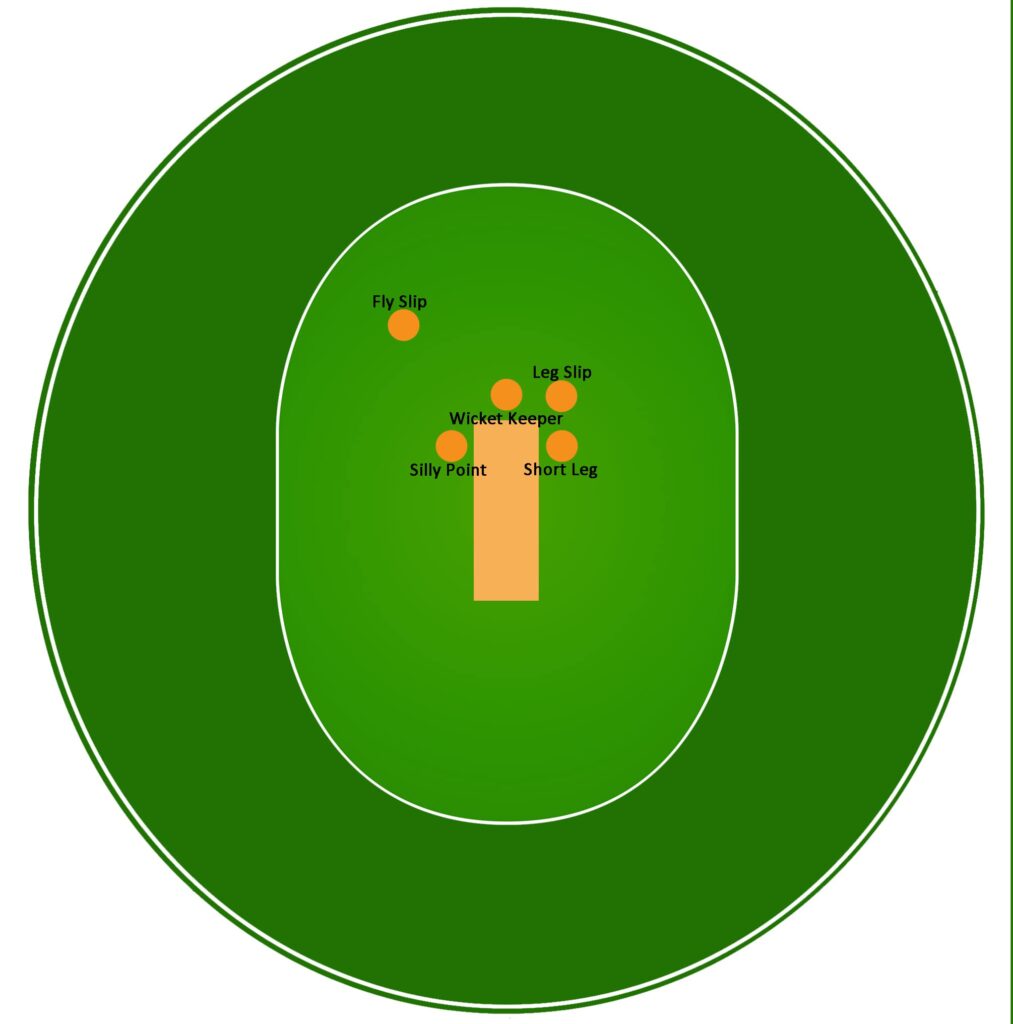
Wicketkeeper
The wicketkeeper is stationed directly behind the batsman, ready to catch any edges and effect stumpings. The keeper is key to the fielding setup. He must gather balls that pass the batsman and coordinate the fielders’ positions.
Silly Point
Silly point is positioned very close to the batsman on the off-side, near the wicket. This aggressive position is used to catch deflections and mishits, particularly off spin bowling.
Short Leg
A short leg is located close to the batsman on the leg side. The fielder in this position is placed to catch deflections and mistimed shots, requiring quick reflexes and bravery.
Leg Slip
The leg slip is positioned behind the batsman on the leg side, parallel to the regular slip. This position is used for catching leg-side deflections and glances.
Fly Slip
Fly slip is located in the outfield behind the regular slip positions. This position is used to catch edges that are hit over the slips and is often employed for fast bowlers.
Fielding Strategies and Formations
Cricket’s fielding strategies and formations are vital. They maximize defense and pressure the batting side. These strategies vary with the match situation and pitch. They also depend on the strengths and weaknesses of the bowlers and batsmen. Other than the above-mentioned position there are some variations of the positions. Which can better be understood from the image bellow
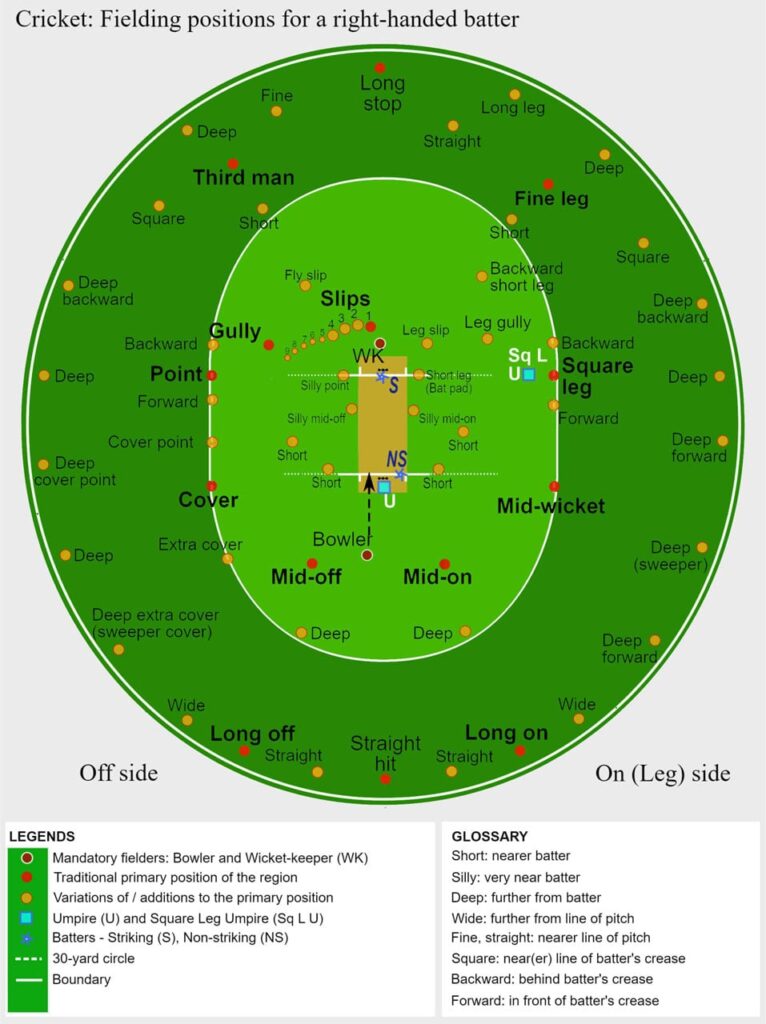
Attacking Field
An attacking field is set to create more catches. It is often used when the bowling team wants to take wickets. This strategy involves placing more fielders in catching positions. These include slips, gully, and close-in fielders like silly point and short leg. The goal is to capitalize on any edges or mistimed shots from the batsman.
Defensive Field
A defensive field aims to restrict runs. It is used when the batting team is scoring freely. This formation puts more fielders on the boundary to stop boundaries and cut off singles. Positions such as deep square leg, third man, and long on/off become more prominent.
Balanced Field
A balanced field mixes attacking and defensive strategies. It aims to maintain pressure while controlling the run rate. This formation has close-in catchers and boundary riders. It lets the fielding team adapt to the game’s changing dynamics.
Powerplay Strategies
In limited-overs cricket, powerplay overs restrict the number of fielders outside the inner circle. During this period, teams often use aggressive field settings. They want to take early wickets or restrict runs. So, they put players at slip, gully, and short midwicket.
Spin Bowling Formations
When spinners are bowling, fielding formations are adjusted to maximize spin impact. Close-in fielders like slip and short leg catch edges and deflections. Also, fielders are placed to stop singles and put pressure on the batsman.
Conclusion
Understanding cricket fielding positions is essential for players and fans. Each position has a specific role. It contributes to the team’s strategy and effectiveness in defense and attack. By mastering fielding placements, teams can take more wickets and limit runs. So, fielding is vital in cricket. Whether it’s the agility of infielders or the precision of outfielders. Every player plays a vital part in the success of the team. As you watch or play cricket, note the fielding positions and strategies. This will deepen your appreciation for the sport.







